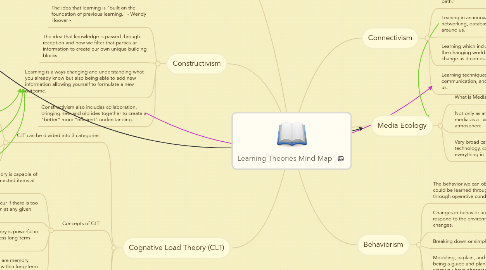
1. Constructivism
1.1. The idea that learning is "built on the foundation of previous learning." - Wendy Hoover -
1.2. The idea that knowledge is passed through reception and how we filter that particular information to create our own unique building blocks.
1.3. Learning is always changing and understanding what you already know but also being able to add new information allowing yourself to formulate a new outcome.
1.4. Constructivism also includes collaboration, bringing new and old ides together to create a "better" more "efficient" understanding.
2. Cognative Load Theory (CLT)
2.1. CLT can be divided into 3 categories:
2.1.1. Working Memory (Thinking and Awareness)
2.1.2. Long Term Memory (Stored factual and procedural knowledge).
2.1.3. Schemas
2.2. Concepts of CLT
2.2.1. The working memory is capable of attaining 7 disconnected items at once.
2.2.2. Overload can occur if there is too much information at any given time.
2.2.3. Working memory is powerful in that it can access long-term memory.
2.2.4. "Schemas are memory structures within long-term memory."
2.3. 3 Types of Cognitive Load
2.3.1. Extraneous
2.3.2. Intrinsic
2.3.3. Germane
2.4. Applying CLT in a functional way can have meaningful results 3 Ways to get them:
2.4.1. 1. Knowledge Compression (Clumping)
2.4.1.1. presenting important information in chunks
2.4.2. 2.Repetition
2.4.3. 3. Use "information Landscapes" to provide meaningful splits to keep the attention of your peers.
3. What is TPACK?
3.1. TPACK stands for Technological Pedagogy Context Knowledge Technology
3.1.1. There are 3 main focus groups in the circle of TPACK
3.1.1.1. Technological - which includes knowledge of technology and the changing processes.
3.1.1.2. Context - The actual concept that you as a teacher are trying to convey.
3.1.1.3. Pedagogical - How will you teach that information
3.1.2. How are these focus groups related?
3.1.2.1. The relationship is really that in my opinion one cannot exist without the other, in order to really be good teacher.
3.1.2.2. Technological, really is integrated with context and pedagogy in the 21st century in a lot of what we teach and how we teach it will mean integrating the tools of technology. The focus groups work together and will ultimately effect the way in which we convey the message.
4. Connectivism
4.1. An integration of how one learns, without sticking to a 'one-dimensional path.'
4.2. Leaning in an innovative way that may include; networking, databases, and the digital world around us.
4.3. Learning which includes, keeping an open mind to the changing world around us and embracing the change as it comes.
4.4. Learning techniques using networking, communication, and using the resources around us.
5. Behaviorism
5.1. The behavior we can observe, how behaviors could be learned through the environment and through operative condition.
5.2. Changes in behavior are how one will respond to the environments changes.
5.3. Breaking down or simplifying the task.
5.4. Modeling, explain, and demonstrate each stage being a guide and planning each lesson based on what you have observed.
5.5. The environment influences the way a student learns and interprets information, providing a space, along with guided instruction can lead to success.
6. Media Ecology
6.1. What is Media Ecology?
6.1.1. The study of Media as environments.
